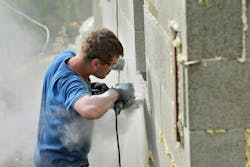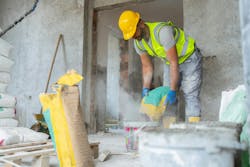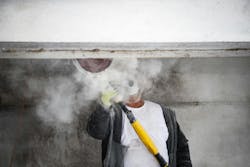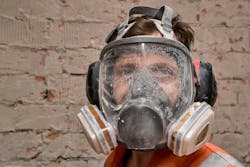The complex and sometimes dangerous array of tasks involved in building a new home require builders and contractors to ensure a safe working environment that adheres to standards set by the federal Occupational Health and Safety Administration (OSHA).
One significant yet often underestimated construction jobsite risk is exposure to respirable crystalline silica, from which prolonged inhalation can lead to serious health issues, including lung cancer.
Respirable crystalline silica (RCS) refers to very small particles of crystalline silica that can become airborne while cutting, grinding, and polishing materials such as masonry, natural and artificial stone, concrete, and tile, which often contain more than 10% crystalline silica.
It is crucial to understand how to protect workers engaged in these high-exposure tasks and to manage and limit their exposure to harmful dust particulates to keep them healthy.
How Much Exposure to Silica Dust Is too Much?
According to OSHA regulations, the permissible exposure limit for RSP is set at 50 micrograms per cubic meter of air based on an 8-hour time-weighted average—the maximum allowable concentration of silica that a worker can be exposed to during a full workday.
RELATED
- Don’t Cut Corners on Construction Jobsite Safety
- Construction Jobsite Safety: Strategies and Resources for Worker Well-Being
- PPE Products for Increased Jobsite Safety
Consider the examples of siding contractors cutting cementitious cladding materials for 8 hours a day, five days a week. Or trades that work with tile or granite countertops, as well as those cutting clay roof tiles or concrete slabs.
All of them, and others in similar roles, are at risk, including others working nearby, as silica dust can remain airborne for hours, posing risks even after the immediate task is completed.
Moreover, the development of silicosis can take years, particularly with chronic silicosis, which typically arises after a decade or more of low-level silica exposure. Inhalation of these small crystalline particles can lead to multiple health conditions, including the incurable lung disease silicosis, lung cancer, chronic obstructive pulmonary disease (COPD), and kidney disease.
What Is SIlicosis?
Silicosis is a lung disease caused by breathing in particles of silica. It is a type of pulmonary fibrosis that results in scarring and thickening of the tissue around and between the air sacs (alveoli) in the lungs over time. Silicosis symptoms include shortness of breath, a dry cough, feeling tired, weight loss, and nail clubbing. Complications may include pulmonary hypertension, respiratory failure, and lung cancer.
7 Ways to Reduce Exposure to Silica Dust
To address silica dust or any other harmful exposure, it's essential to adopt a proactive approach, considering these basic but effective controls:
- Wet methods: Apply water directly to the cutting point of saws and drills to suppress dust generation during cutting, drilling, and grinding operations.
- Local exhaust ventilation (LEV): Use dust collection systems with hoods positioned close to the dust source to capture airborne silica particles … though this may be difficult to execute effectively in the field.
- Vacuum dust collection: Connect power tools to a high-efficiency vacuum system with HEPA filters to capture dust at the source.
- Material selection: Consider using alternative building materials with lower silica content whenever possible.
- Respiratory protection: Provide workers with appropriate respirators based on the level of exposure and ensure proper fit and maintenance.
- Work area isolation: Enclose at-risk work areas with plastic sheeting or temporary barriers to contain dust, with a strong emphasis on implementing additional measures (such as water suppression) rather than solely relying on personal protective equipment.
- Worker training: Educate workers about the hazards of silica exposure, proper work practices, and the importance of using required personal protective equipment.
Keys to Long-Term Success in Limiting Silica Dust Exposure
- Regularly check and maintain dust collection systems, including filters, to ensure optimal performance.
- Conduct air monitoring tests to assess silica exposure levels in the work area and identify areas for improvement.
- Encourage workers to wash their hands and face thoroughly after exposure to silica dust.
- Follow all applicable OSHA regulations regarding silica exposure limits and control measures.
Among the many hazards present on a typical construction site, exposure to RSC stands out because silica dust often appears harmless and its detrimental effects on long-term health can develop gradually.
About the Author
John Koenig
John Koenig drives quality and performance in home building as a building performance specialist on the PERFORM Builder Solutions team at IBACOS.





